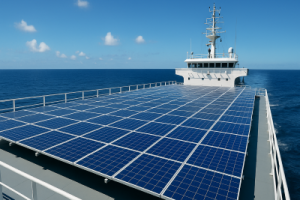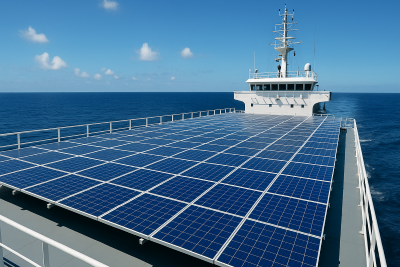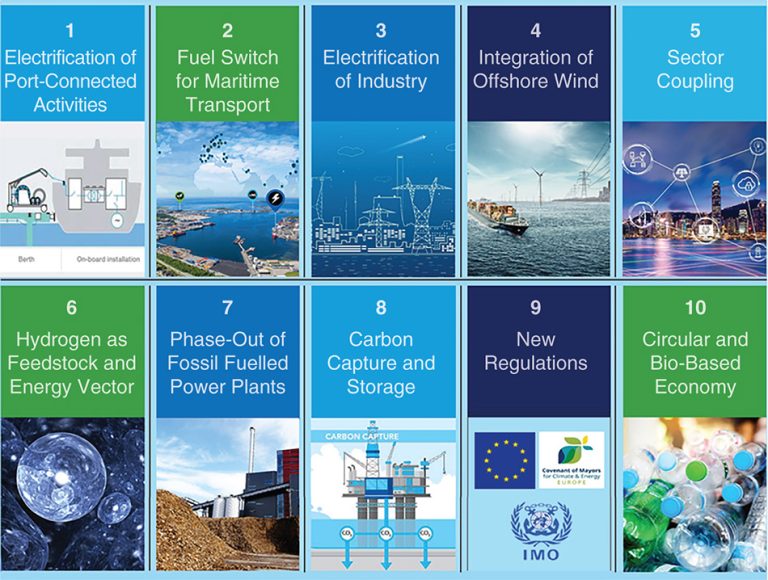How Solar Panels Power Ships at Sea?
Introduction
As the worldwide shipping industry seeks cleaner options to replace fossil fuels, solar energy has emerged as a promising renewable power source. But how do solar panels actually provide energy to ships on the ocean? From minimizing emissions to lowering operational expenses, this technology is revolutionizing the maritime field. In this blog, we will examine how solar panels function on vessels, the systems they energize, and the potential they offer for a greener future.

The Importance of Solar Energy on Vessels
The shipping sector plays a significant role in global greenhouse gas emissions. Thus, discovering effective and environmentally friendly alternatives is essential.
Solar power is appealing because it is:
- Abundant and renewable
- Silent and non-polluting
- Requires minimal upkeep once set up
- Cost-efficient over the long run
While solar panels may not completely replace marine engines at least not immediately. However, they can assist in meeting power demands and lessen dependence on diesel generators.
How Solar Energy Work on Vessels?
Solar panels mounted on ships function much like those on land. They capture sunlight and convert it into electrical energy through photovoltaic (PV) cells. However, incorporating them into a maritime setting necessitates careful planning due to challenges related to space, movement, and corrosion.
-
Installation of Solar Panels
Solar panels are generally placed on the ship’s deck, roof structures, or any flat surfaces exposed to sunlight. Panels designed for marine use are built to endure tough conditions such as saltwater spray, high humidity, and strong winds.
To enhance efficiency, panels are positioned at angles that maximize sunlight collection throughout the journey. Some vessels also utilize flexible or semi-flexible panels that adapt to curved surfaces, thus optimizing space utilization.
-
Uninterruptible Power Supply and Storage
After solar panels collect sunlight, the energy is sent to an inverter. This device changes direct current (DC) into alternating current (AC), which powers onboard systems.
Since ships operate continuously, energy storage is crucial. Batteries store surplus solar energy during daylight for use at night or during overcast weather. Lithium-ion batteries are often preferred due to their high energy density and resilience.
-
Integration with Ship Electric Systems
Solar energy typically powers the ship’s auxiliary systems rather than the main propulsion. This includes:
- Lighting
- Air conditioning
- Navigation equipment
- Refrigeration
- Communication systems
By managing these secondary loads, solar panels decrease the fuel needed to operate generators, thus reducing emissions and lowering fuel expenses.
Real-World Instances of Solar-Powered Vessels
Solar panels are already in use on various ships around the globe, ranging from cargo vessels to recreational yachts. Here are some notable examples:
-
MS Tûranor PlanetSolar
Inaugurated in 2010, PlanetSolar was the first vessel to sail around the world using solely solar energy. Equipped with 537 square meters of solar panels, it demonstrated the feasibility of solar marine technology on a global scale.
-
NYK Line’s Auriga Leader
This automobile transport vessel, managed by Nippon Yusen Kaisha (NYK), was equipped with 328 photovoltaic solar panels. Although this system contributed a mere 0.05% of the vessel’s overall energy requirements, it exemplified the reliability of solar panels in marine environments.
-
Eco Marine Power’s Aquarius MRE
The Aquarius Marine Renewable Energy (MRE) apparatus amalgamates rigid photovoltaic panels with wind-assisted propulsion mechanisms. This hybrid configuration aspires to furnish sustainable energy for substantial cargo vessels and tankers.
-
Solar-Powered Yachts
Luxury and leisure craft have progressively embraced solar energy technologies. Vessels such as Silent 60 and Soel Senses 62 predominantly utilize solar power, thereby demonstrating that emissions-free navigation is both feasible and aesthetically appealing.
Advantages of Solar Powered Ships
The integration of solar energy into maritime operations confers numerous advantages:
-
Environmental Impact
Through the mitigation of fuel consumption, solar-powered vessels emit significantly lower levels of pollutants. This assists shipowners in adhering to increasingly stringent international regulations, such as IMO 2020, which imposes limitations on sulfur emissions.
-
Economical Effect
Although the initial financial outlay is considerable, solar panels ultimately diminish fuel and maintenance expenditures over time. For extended voyages, this can culminate in significant economic benefits.
-
Energy Independence
Solar energy provides vessels with a degree of energy self-sufficiency, which is particularly advantageous in remote or underdeveloped ports where access to shore power may be limited.
-
Noiseless Operation
In contrast to raucous diesel engines, solar energy systems operate with minimal noise. This alleviates noise pollution, which is especially crucial for research vessels and eco-tourism endeavors.
-
Less Maintenance
Photovoltaic panels possess minimal moving components and generally require limited maintenance. Marine-grade solar panels are particularly robust and designed to endure for decades with minimal intervention.
Challenges and Limitations
Despite its promise, the utilization of solar energy in maritime contexts is accompanied by various challenges.
-
Limited Open Area
Maritime vessels have constrained surface areas, which restricts the number of solar panels that can be installed. This limitation complicates the fulfillment of energy demands solely through solar power.
-
Climate-Dependent
The efficiency of solar energy generation is significantly reduced during overcast conditions or inclement weather. Although battery storage systems offer some mitigation, solar panels cannot reliably supply energy without sufficient sunlight.
-
High Initial Investment
The installation of marine solar systems necessitates specialized equipment and engineering expertise. Consequently, the initial investment is substantially greater than that associated with terrestrial systems.
-
Inadequate for Propulsion
Current solar energy technologies do not generate sufficient power to entirely supplant diesel engines in large commercial vessels. Nevertheless, ongoing research and the development of hybrid systems are progressively addressing this shortfall.
The Future of Solar Panels in Maritime Shipping
In spite of these challenges, the prospects for solar-powered shipping appear promising. Technological advancements, decreasing costs of solar panels, and heightened environmental consciousness are propelling the adoption of these systems.
Indeed, numerous shipping enterprises are currently investigating hybrid solutions that amalgamate solar, wind, and battery technologies to diminish fuel consumption and emissions. These integrated methodologies are perceived as essential steps towards realizing decarbonization objectives.
Furthermore, regulatory frameworks and incentives are fostering innovation within this sector. Governmental and international organizations are investing in initiatives aimed at clean shipping, providing subsidies and accolades to trailblazers in sustainable maritime technologies.
Conclusion
So, how do solar panels power ships at sea? Although they may not be the main source of propulsion just yet, solar panels are essential for lowering emissions, lowering fuel consumption, and supporting onboard systems. They mark a significant advancement in the maritime sector’s quest for sustainability.
We can anticipate solar power to become even more important in marine energy strategies as costs decrease and technology advances. The sun is helping ships sail cleaner and smarter into the future, whether they are private yachts or cargo ships.




